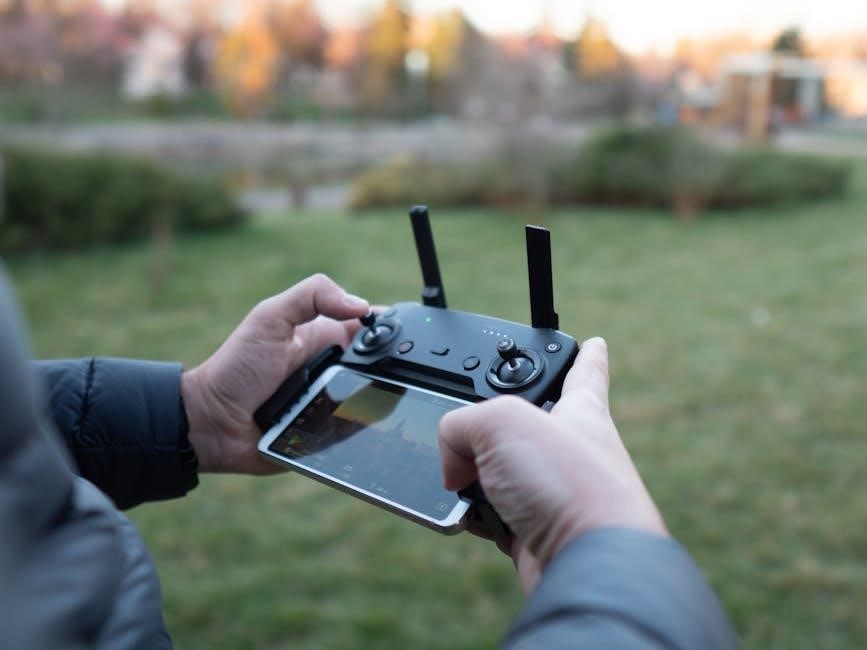
sel 351 user manual
Welcome to the SEL-351 User Manual, your comprehensive guide to understanding and operating the Schweitzer Engineering Laboratories SEL-351 Protection System․ Designed for engineers and technicians, this manual provides detailed instructions, technical specifications, and troubleshooting tips to ensure optimal use of the SEL-351 relay․ Explore its advanced features, including directional overcurrent protection, fault location, and Ethernet communication capabilities, to maximize your system’s performance and reliability․
1․1 Overview of the SEL-351 Protection System
The SEL-351 is a multifunctional protection system designed for directional overcurrent, reclosing, and fault location applications․ It integrates advanced features like built-in Ethernet communication and IEEE C37․118 synchrophasors for precise system monitoring․ Ideal for utility and industrial power systems, the SEL-351 offers economical and reliable protection solutions․ Its user-friendly interface and robust functionality make it a trusted choice for engineers and technicians seeking high-performance power system protection․
1․2 Applications of the SEL-351 Relay
The SEL-351 relay is widely used in utility and industrial power systems for feeder protection, reclosing control, and fault location․ It excels in directional overcurrent applications, ensuring reliable protection for distribution lines․ Additionally, it supports synchrophasor measurements for system stability and integrates seamlessly with SCADA systems․ Its versatility makes it suitable for various electrical networks, providing advanced monitoring and control capabilities to enhance system performance and reliability․
1․3 Brief History and Development of the SEL-351
The SEL-351 relay was first introduced by Schweitzer Engineering Laboratories (SEL) to address the growing need for advanced protection systems․ Over the years, it has evolved to incorporate cutting-edge technologies, such as built-in Ethernet and IEEE C37․118 synchrophasors․ Initially designed for directional overcurrent protection, the SEL-351 expanded its capabilities to include reclosing control and fault location․ Continuous updates, like the introduction of SELogic control equations, have solidified its reputation as a reliable and versatile protection solution for utility and industrial applications worldwide․

Key Features of the SEL-351
The SEL-351 offers advanced features like built-in Ethernet, IEEE C37․118 synchrophasors, directional overcurrent protection, reclosing relay functionality, and fault locator capabilities, ensuring robust protection and control solutions․
2․1 Built-in Ethernet and IEEE C37․118 Synchrophasors
The SEL-351 features built-in Ethernet connectivity, enabling seamless communication and integration with modern power systems․ Supporting IEEE C37․118 synchrophasors, it provides precise timing and synchronization, enhancing system stability and diagnostics․ This capability allows for real-time data transmission, improving monitoring and control․ The combination of Ethernet and synchrophasors ensures accurate and reliable operation, making the SEL-351 a robust solution for advanced power protection and monitoring applications․
2․2 Directional Overcurrent Protection
The SEL-351 provides advanced directional overcurrent protection, essential for utility and industrial power systems․ This feature enhances reliability by detecting faults in specific directions, ensuring precise tripping for overcurrent conditions․ The relay’s directional element logic minimizes unnecessary tripping, improving system stability․ With adjustable settings and sensitivity, it offers flexibility for various network configurations․ Combined with ground directional logic, it ensures accurate fault detection and isolation, making it a critical component for maintaining power system integrity and operational efficiency․
2․3 Reclosing Relay Functionality
The SEL-351 incorporates robust reclosing relay functionality, enabling automatic reclosure of circuit breakers after fault detection․ This feature minimizes downtime by allowing the system to restore power quickly․ It supports both manual and automatic reclosing modes, with synchronism check and voltage condition logic ensuring safe reclosure․ Adjustable reclosing sequences and intervals enhance operational flexibility․ This functionality is crucial for maintaining system reliability and reducing operational interruptions, making it an essential tool for modern power distribution networks․
2․4 Fault Locator Capabilities
The SEL-351 features advanced fault locator capabilities, enabling precise identification of fault locations on power systems․ By calculating fault distance and detecting fault types, it enhances troubleshooting efficiency․ This functionality integrates seamlessly with the relay’s protection and communication features, providing detailed insights for quick resolution․ The fault locator reduces repair times and improves system reliability, making it an indispensable tool for utilities and industrial applications․ Its accuracy and speed ensure minimal downtime, optimizing overall system performance and operational effectiveness;
2․5 SELogic Control Equations
SELogic control equations provide advanced flexibility in customizing relay behavior․ Users can create complex logic equations to define specific operation conditions, combining inputs and settings for tailored responses․ This feature enhances automation and adaptability, allowing precise control over protection and reclosing functions․ SELogic equations can be programmed to trigger actions based on specific fault conditions or system states, ensuring optimal performance in various power system configurations․ This capability streamlines operations and improves reliability, making the SEL-351 highly configurable for diverse applications and operational needs․
2․6 Best Choice Ground Directional Element Logic
The Best Choice Ground Directional Element Logic enhances ground fault protection by providing advanced directional sensing and fault detection․ This feature ensures accurate identification of ground faults, improving relay responsiveness and reducing false trips․ It integrates seamlessly with the SEL-351’s protection suite, offering reliable operation in various power system configurations․ The logic is designed to optimize ground fault protection, ensuring minimal downtime and enhancing overall system reliability․ This advanced capability makes the SEL-351 a robust solution for modern electrical systems requiring precise ground fault management․

Technical Specifications of the SEL-351
The SEL-351 operates with versatile voltage and current ratings, supports Ethernet and Mirrored Bits communications, and features advanced hardware components like a powerful processor and expandable memory․
3․1 Voltage and Current Ratings
The SEL-351 supports a wide range of voltage and current ratings, ensuring compatibility with various electrical systems․ It operates on nominal voltages up to 600VAC and accepts currents from 1A to 5A․ The relay is designed to handle both single-phase and three-phase configurations, making it versatile for different applications․ Its robust design ensures accurate operation across the specified voltage and current ranges, providing reliable protection and control in utility and industrial power systems․ These ratings are detailed in the product specifications to guide proper installation and setup․
3․2 Communication Protocols
The SEL-351 supports advanced communication protocols, including Ethernet and IEEE C37․118 for synchrophasors; It enables seamless integration with SCADA systems, allowing real-time monitoring and control․ The relay also supports Mirrored Bits communications for enhanced data transmission reliability․ These protocols ensure efficient and accurate data exchange, making the SEL-351 a robust solution for modern power systems․ Detailed configuration guidelines are provided in the manual to facilitate smooth setup and operation of these communication features․
3․3 Hardware Components and Connectors
The SEL-351 features a range of hardware components designed for reliable performance․ It includes screw terminal blocks for secure connections, Ethernet ports for communication, and optional I/O modules for expanded functionality․ The relay also supports user-configurable labels for easy identification․ Detailed wiring diagrams and pin layouts are provided in the manual to ensure correct installation․ These components are built to withstand harsh environments, ensuring long-term durability and system integrity․

Installation and Setup
The SEL-351 installation involves mounting the relay, connecting voltage and current inputs, and configuring communication ports․ Ensure proper wiring and setup for optimal performance and reliability․
4․1 Hardware Installation Requirements
The SEL-351 requires proper mounting on a DIN rail and connection to a 24 Vdc power supply․ Ensure the relay is installed in a dry, cool environment to prevent damage․ Verify voltage and current transformer ratios match the system requirements․ Ground the relay correctly to avoid noise interference․ Use the provided screw terminal blocks for secure connections․ Refer to the manual for specific torque and wiring guidelines․ Always follow safety protocols when handling electrical equipment to ensure a safe and reliable installation․
4․2 Software Setup and Configuration
Install the SEL-351 software tools to configure settings like protection curves and communication protocols․ Connect the relay to your PC via Ethernet or serial connection․ Use SEL’s software to load settings groups and customize logic equations․ Ensure proper configuration of IEEE C37․118 synchrophasors for accurate phasor measurements․ Test communication by pinging the relay’s IP address․ Validate settings by simulating fault conditions․ Backup configurations regularly to avoid data loss․ Refer to the manual for detailed step-by-step instructions and troubleshooting tips to ensure smooth operation․
4․3 Wiring and Connection Guidelines
Ensure proper wiring by following the SEL-351 connection diagrams in the manual․ Connect voltage and current transformers accurately, adhering to rated specifications․ Secure all ground connections to prevent noise interference․ Use appropriate cables for Ethernet and serial communications․ Verify CT and VT polarities for correct operation․ Tighten terminal blocks firmly to avoid loose connections․ Use shielded cables for sensitive circuits․ Refer to the wiring guide for specific pin assignments and communication port configurations․ Double-check all connections before powering up the relay to ensure reliable operation and safety․

Operation and Configuration
The SEL-351 operates using advanced synchrophasors and SELogic control equations for precise protection․ Configure settings via Ethernet or serial interfaces for optimal performance and network stability․
5․1 Basic Operating Principles
The SEL-351 operates by monitoring voltage and current inputs to detect faults and overcurrent conditions․ It uses advanced algorithms, including SELogic control equations, to ensure accurate protection․ The relay employs directional overcurrent protection to distinguish between faults occurring within or outside the protected zone․ Built-in IEEE C37․118 synchrophasors enhance system stability by providing real-time phasor measurements․ Ground directional element logic further improves fault detection accuracy․ These principles ensure reliable, fast, and precise operation, making the SEL-351 ideal for utility and industrial power systems․ Proper configuration and settings are essential for optimal performance․
5․2 Protection Settings and Logic
The SEL-351 allows users to configure protection settings based on system requirements․ SELogic control equations enable customized logic for advanced protection strategies․ Directional overcurrent and ground fault protection settings ensure precise fault detection․ The Best Choice Ground Directional Element Logic simplifies ground fault protection configuration․ Users can define thresholds, time delays, and enable/disable specific protection functions․ Accurate setting configuration is critical for reliable operation․ The relay’s flexibility allows adaptation to various power system conditions, ensuring optimal protection and minimizing unwanted tripping․ Proper setup requires understanding of the system’s electrical characteristics and protection objectives․
5․3 Reclosing Control and Synchronism Check
The SEL-351 offers advanced reclosing control with automatic or manual operation․ It performs a synchronism check to ensure safe and reliable circuit reclosure․ The relay verifies voltage and phase angle conditions before allowing reclosing, preventing out-of-sync closures․ Customizable settings enable users to define reclose intervals and sequence logic․ This feature minimizes downtime by quickly restoring power after temporary faults․ The synchronism check ensures system stability, while reclosing control adapts to specific power system requirements, enhancing operational efficiency and reliability in utility and industrial applications․

Communications and Integration
The SEL-351 supports Ethernet communications and IEEE C37․118 synchrophasors for real-time data transmission․ It also features Mirrored Bits for reliable communication between devices․ The relay seamlessly integrates with SCADA systems, enabling remote monitoring and control․ Flexible communication options ensure compatibility with various network configurations, making it ideal for modern power systems․
6․1 Ethernet Communications
The SEL-351 features built-in Ethernet communication, enabling seamless connectivity for real-time data transmission․ It supports IEEE C37․118 synchrophasors for precise system monitoring․ The relay’s Ethernet interface simplifies integration with SCADA systems, allowing remote monitoring and control․ With TCP/IP and UDP protocol support, the SEL-351 ensures reliable communication across utility and industrial networks․ Its user-friendly interface and robust security features make it ideal for modern power system applications, ensuring efficient and secure data exchange․
6․2 Mirrored Bits Communications
Mirrored Bits communications in the SEL-351 provide a reliable method for duplicating control signals, ensuring seamless operation in critical power systems․ This feature allows engineers to configure the relay to mirror specific inputs and outputs, enhancing redundancy and system reliability․ By enabling backup controls and minimizing downtime, Mirrored Bits communications are ideal for applications requiring high availability․ The SEL-351’s intuitive setup ensures easy configuration, making it a robust solution for maintaining continuous operation in industrial and utility environments․
6․3 Integration with SCADA Systems
The SEL-351 seamlessly integrates with SCADA systems through its built-in Ethernet capabilities and support for standard communication protocols․ This integration allows real-time monitoring and control of power systems, enabling efficient management and quick response to system events․ Engineers can easily configure the relay to transmit critical data, such as fault locations and operational statuses, directly to SCADA systems․ This high-level integration enhances operational visibility and supports data-driven decision-making for utility and industrial applications, ensuring reliable and efficient system performance․

Maintenance and Troubleshooting
Perform routine maintenance to ensure optimal performance․ Check for firmware updates, inspect connections, and verify settings․ Refer to error codes for quick issue resolution and use diagnostic tools for advanced troubleshooting․
7․1 Routine Maintenance Procedures
Regular maintenance is essential for ensuring the SEL-351 operates efficiently․ Update firmware periodically to access new features and improvements․ Inspect hardware connections and verify settings alignment with system requirements․ Monitor error logs for early detection of potential issues․ Clean the enclosure to prevent dust buildup․ Check the condition of the 24 Vdc battery, as it is excluded from the product warranty․ Refer to the user manual for detailed diagnostic tools and troubleshooting guidance to maintain optimal performance and reliability․
7․2 Common Error Codes and Solutions
Familiarize yourself with common error codes to ensure timely resolution․ Error code 101 indicates a communication loss, while code 102 suggests a firmware update failure․ For code 103, check sensor connections and verify calibration․ Code 104 signals a battery issue, requiring immediate attention․ Refer to the manual for detailed solutions, such as restarting the relay or updating firmware․ Always ensure proper power supply and stable network connections to prevent errors․ Regularly review the error log to address issues before they escalate․
7․3 Diagnostic Tools and Techniques
The SEL-351 offers advanced diagnostic tools to identify and resolve issues efficiently․ Utilize built-in IEEE C37․118 synchrophasors for real-time system monitoring and fault analysis․ The fault locator feature helps pinpoint fault locations, reducing repair times․ Refer to the instruction manual for troubleshooting guides and error code solutions․ Regular firmware updates ensure optimal performance and address known issues․ Use diagnostic software to analyze relay operations and verify settings․ Always perform routine checks on connections and configurations to prevent potential malfunctions and maintain system reliability․

Accessories and Upgrades
The SEL-351 supports various accessories, including optional hardware components and user-configurable labels, while software upgrades enhance functionality and ensure system optimization for improved performance․
8․1 Optional Hardware Accessories
The SEL-351 offers optional hardware accessories to enhance its functionality․ These include screw terminal blocks for easier wiring, independent SafeLock trip/close pushbuttons for improved operator control, and additional communication modules․ Other accessories like mirrored bits communication cards and power quality monitoring devices can be integrated to expand the relay’s capabilities․ These optional components allow users to customize the SEL-351 to meet specific system requirements, ensuring flexibility and adaptability in various electrical protection and control applications․
8․2 Software Upgrades and Updates
The SEL-351 supports software upgrades to enhance functionality and performance; Regular updates ensure the relay operates with the latest features and security patches․ Users can download firmware updates from the SEL website and install them using SEL’s software tools, such as the SEL-5033 System Configuration Tool․ These updates may include new protection algorithms, communication protocols, or user interface improvements․ Always refer to the instruction manual for detailed instructions on performing software updates safely and effectively to maintain optimal system operation and reliability․
8․3 User-Configurable Label Options
The SEL-351 offers user-configurable label options, allowing for personalized settings and enhanced organization․ Users can customize labels on the front panel to match specific applications or preferences․ This feature simplifies system navigation and ensures clarity in complex configurations․ Configurable labels support a variety of settings, including text and symbols, to provide clear identification of functions․ This customization capability makes the SEL-351 adaptable to diverse operational needs, improving efficiency and reducing potential errors during operation or maintenance․

Compliance and Certification
The SEL-351 complies with industry standards like IEEE and IEC, ensuring reliability and safety․ It meets environmental regulations and holds certifications for safe operation in various applications․
9․1 Industry Standards Compliance
The SEL-351 adheres to key industry standards, ensuring interoperability and reliability․ It complies with IEEE C37․118 for synchrophasors and IEC 61850 for substation automation․ Additionally, it meets UL 891 and ISO 9001 standards, guaranteeing quality and safety․ Compliance with these standards ensures seamless integration into power systems worldwide, meeting the requirements of utilities and industrial applications․ This adherence to standards reinforces the SEL-351’s reputation as a reliable and advanced protection relay․
9․2 Environmental and Safety Certifications
The SEL-351 meets rigorous environmental and safety standards․ It complies with RoHS and REACH regulations, ensuring minimal environmental impact․ Safety certifications include UL 1604 for hazardous locations and IEC 61010-2-201 for electrical safety․ The relay is also CE-marked and FCC-compliant, guaranteeing electromagnetic compatibility․ These certifications ensure the SEL-351 operates safely in industrial and outdoor environments, meeting global standards for reliability and environmental responsibility․ This robust compliance underscores its suitability for diverse power system applications worldwide;
9․3 Product Warranty and Support
The SEL-351 is backed by a comprehensive warranty and dedicated customer support․ The standard warranty covers defects in materials and workmanship for a specified period, ensuring reliability․ Certain components, like the 24 Vdc battery in the SEL-351R, are excluded from the warranty․ For detailed warranty terms, refer to the official SEL website or contact their support team․ Additionally, SEL provides extensive technical resources, including manuals, FAQs, and expert assistance, to help users troubleshoot and maintain their devices effectively․

User Manual Sections
The SEL-351 User Manual includes sections on instruction overview, hardware connections, features, specifications, settings, and communications, providing a detailed guide for installation, configuration, and operation․
10․1 Instruction Manual Overview
This section provides a comprehensive overview of the SEL-351 Instruction Manual, detailing its structure and content․ It includes guidance on installation, configuration, and operation, ensuring users can effectively utilize the relay’s features․ The manual is divided into key sections, such as hardware connections, protection settings, and communications, offering a clear roadmap for understanding and implementing the SEL-351’s advanced functionalities․ This overview serves as the foundation for navigating the entire manual, helping users access critical information efficiently․
10․2 Hardware Connection Guide
The Hardware Connection Guide provides detailed instructions for connecting the SEL-351 relay to power systems, ensuring proper installation and functionality․ It outlines voltage, current, and communication connector configurations, as well as wiring requirements․ The guide also covers terminal block connections and optional accessories, such as Ethernet ports for synchrophasor data transmission․ Clear diagrams and step-by-step instructions help users navigate complex wiring scenarios, ensuring compliance with safety standards and optimal system performance․ This section is essential for technicians and engineers responsible for installing and maintaining the SEL-351 protection system․
10․3 Features and Specifications
The Features and Specifications section highlights the advanced capabilities of the SEL-351 relay, including built-in Ethernet and IEEE C37․118 synchrophasors for precise system monitoring; It details the directional overcurrent protection, reclosing relay functionality, and fault locator capabilities․ This section also outlines the technical specifications, such as voltage and current ratings, communication protocols, and hardware components, ensuring users understand the relay’s performance and compatibility․ By reviewing this section, users can fully leverage the SEL-351’s innovative features to enhance their power system’s reliability and efficiency․
10․4 Settings and Configuration Guide
This section provides a detailed guide for configuring the SEL-351 relay, ensuring optimal performance for your power system․ It covers setting up protection parameters, communication protocols, and reclosing control logic․ Learn how to customize SELogic control equations and utilize built-in tools for real-time monitoring and troubleshooting․ Follow step-by-step instructions to configure directional overcurrent protection, fault locator settings, and synchrophasor capabilities․ Refer to sections 5․2 and 6․1 for additional guidance on protection settings and communication configurations to maximize the relay’s functionality and reliability․
10․5 Communications Connections
This guide outlines the steps for setting up communication connections on the SEL-351 relay․ The relay features built-in Ethernet, supporting IEEE C37․118 synchrophasors for precise data transmission․ Configure network settings to integrate with SCADA systems and enable real-time monitoring․ Use Mirrored Bits communications for redundancy and reliability․ Follow the instructions to establish secure and efficient communication protocols, ensuring seamless data exchange between the SEL-351 and other system components․ Refer to sections 6․1 and 6․3 for detailed configuration procedures and troubleshooting tips․
The SEL-351 user manual provides a detailed guide to installing, configuring, and maintaining the relay․ Its advanced features ensure reliable protection and efficient system management․
11․1 Summary of Key Features and Benefits
The SEL-351 offers advanced protection with built-in Ethernet, IEEE C37․118 synchrophasors, and directional overcurrent capabilities․ It provides reclosing relay functionality, fault location, and SELogic control equations for precise system management․ Its Best Choice Ground Directional Element logic enhances reliability, while optional Mirrored Bits communications and power quality monitoring add flexibility․ Designed for utility and industrial systems, the SEL-351 ensures superior protection, efficient operation, and seamless integration with SCADA systems, making it a trusted solution worldwide for maintaining power system stability and performance․
11․2 Future Prospects and Updates
The SEL-351 continues to evolve with advancements in technology, offering enhanced features and capabilities․ Future updates may include improved cybersecurity measures, expanded communication protocols, and integration with emerging smart grid technologies․ Users can expect periodic software upgrades to maintain optimal performance and compliance with industry standards․ Schweitzer Engineering Laboratories remains committed to innovation, ensuring the SEL-351 remains a cutting-edge solution for power system protection․ Stay informed about the latest developments through official updates and new editions of this user manual․